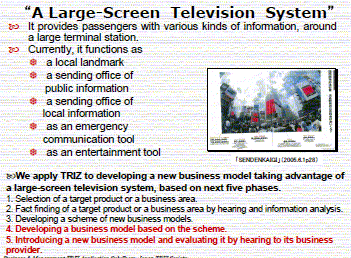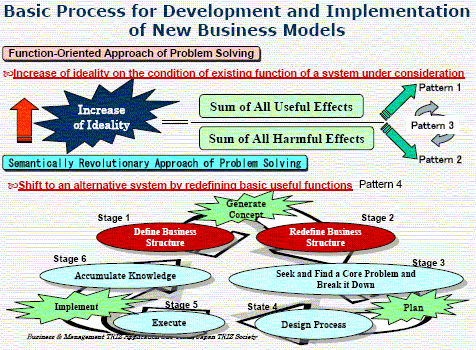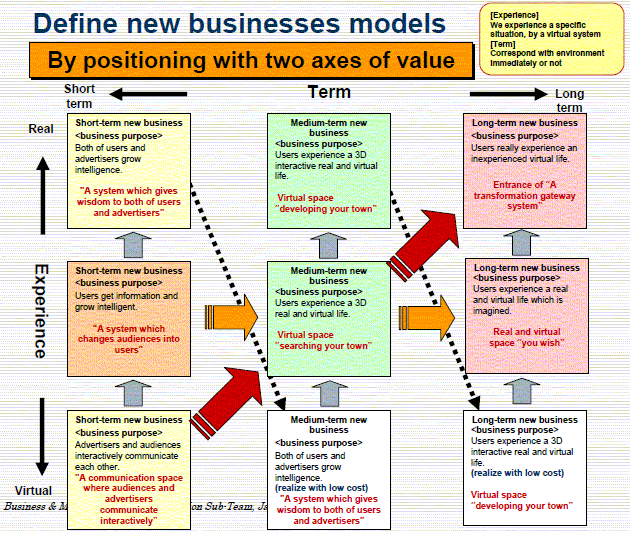 TRIZ Paper: Japan TRIZ Symposium 2010 TRIZ Paper: Japan TRIZ Symposium 2010 |

 
|
An Application of TRIZ Way of Thinking and Its Tools
to Develop a New Business Model |
Business & Management TRIZ Application Sub-Team, Japan TRIZ Society:
Ikuo Yoshizawa (The SANNO Institute of Management), Kimihiko Hasegawa (Ideation Japan Inc. ), Akira Sato (Keio University), Shigeru Kuno (NKN Consulting Co.), Yasuo Moriya (Fujitsu Advanced Technologies), Takuo Maeda (Takumi System Architects), Teruyuki Kamimura (Willfort International Patent Attorneys), Fumiko Kikuchi (Pioneer Corp.), Osamu Ikeda (NIKON Corp.), Hisataka Izawa (Sony Corp.) |
The Sixth TRIZ Symposium in Japan,
Held by Japan TRIZ Society on Sept. 9-11, 2010 at Kanagawa Institute of Technology, Atsugi, Kanagawa, Japan |
| Introduction (from "Personal Report of Japan TRIZ Symosium 2010" ) by Toru Nakagawa (OGU), Apr. 14, 2011 |
| Posted: Sept. 25, 2010 |
For going back to Japanese pages, press  buttons.
buttons.
Editor's Note (Toru Nakagawa, Sept. 23, 2011)
This paper was presented last year by Ikuo Yoshizwa in an Poster session of the 6th TRIZ Symposium in Japan, 2010  . Japan TRIZ Society has posted the presentation slides of this paper, among other contributed papers, in PDF in its Members-only page of the Official Site since last March.
. Japan TRIZ Society has posted the presentation slides of this paper, among other contributed papers, in PDF in its Members-only page of the Official Site since last March.  .
.
For wider circulation of TRIZ papers, I have selected about half of the papers presented at the Japan TRIZ Symposium 2010 and am posting them publicly in this Web site both in English and in Japanese, under the permission of the authors. Nakagawa's introduction/review to each paper was written and posted in "Personal Report of Japan TRIZ Symosium 2010" from November 2010 to April 2011, and is reposted in each page of the paper.
The present page is composed of the followings:
This is the third report of the Study Group. Selecting a specific case of 'Large-Screen Television System' as an example, the Authors developed and discussed how to develop a new business model. They focus on the phase of 'drawing the scheme' (or building the viewpoints for defining/differentiating) of the new business model.
[1] Abstract
An Application of TRIZ Way of Thinking and Its Tools
to Develop a New Business Model
Business & Management TRIZ Application Sub-Team, Japan TRIZ Society:
Ikuo Yoshizawa (The SANNO Institute of Management),
Kimihiko Hasegawa (Ideation Japan Inc. ), Akira Sato (Keio University),
Shigeru Kuno (NKN Consulting Co.), Yasuo Moriya (Fujitsu Advanced Technologies),
Takuo Maeda (Takumi System Architects),
Teruyuki Kamimura (Willfort International Patent Attorneys),
Fumiko Kikuchi (Pioneer Corp.), Osamu Ikeda (NIKON Corp.),
Hisataka Izawa (Sony Corp.)
The 6th Japan TRIZ Symposium 2010
Held by Japan TRIZ Society on Sept. 9-11, 2010
at Kanagawa Institute of Technology, Atsugi, Kanagawa, Japan
Abstract
Most of reported TRIZ applications are for solving technological problems. One of the challenges for TRIZ to be deployed in much wider scale is to prove its capability to help solve business and management problems.
The B & M Application Sub-Team of the Japan TRIZ Society was organized two years ago to address this challenge. We plan to study methods how to apply TRIZ to tackle business and management problems through analysis of real life cases. We intend to make up the guidance for TRIZ application for the purpose. The present report is about our effort up to the present time and some of its results. The subject we choose is “TRIZ application for developing a new model of business that brings in the best economic performance for a given product.”
We divided the process of our study into the following 5 phases;
1. Selection of the target. (A product or a field of business)
2. Understanding the present situation (Interviews and analysis of available information)
3. Drawing a scheme for developing a new business model.
4. Developing a business model based on the scheme.
5. Presentation of the model and the evaluation. (Presentation to subject matter experts and interviews)
We choose as our first target “the Large-Screen Television System”. This report focuses on the above-mentioned phase 3 in the course of our study and clarifies a basic scheme of developing a new business model. This report also provides the results of our research for identifying the components of the new business model for “the Large-Screen Television System,” which we have developed using the above-mentioned basic scheme and based on the result of our previously-conducted study at phases 1 and 2.
The content of the report in fiscal year 2010 makes four of the examination phases a nucleus, locates a new business model in the time axis, and reports on the result of review of the concept construction of a short-term, mid/long-term business model. In addition, it reports on the evaluation result in which the concept of a short-term business model is made a nucleus and the content is presented to the large-scale vision entrepreneurs.
Extended Abstract, PDF in English  in Japanese
in Japanese 
[2] Presentation Slides in PDF
Presentation Slides (Poster Introduction) in English in PDF (4 slides, 149 KB) 
Presentation Slides (Poster Introduction) in Japanese in PDF (4 slides, 245 KB) 
Presentation Slides (Poster) in Japanese in PDF (16 slides, 973 KB) 
[3] Introduction by Nakagawa:
Excerpt from:
Personal Report of
The Sixth TRIZ Symposium in Japan, 2010
Part H. Applications to Soft & Non-technical Areas
Toru Nakagawa (Osaka Gakuin University)
Mar. 30, 2011 (Posted on Apr. 14, 2011) 
Ikuo Yoshizawa (The SANNO Institute of Management), Kimihiko Hasegawa (Ideation Japan Inc. ), Akira Sato (Keio University), Shigeru Kuno (NKN Consulting Co.), Yasuo Moriya (Fujitsu Advanced Technologies), Takuo Maeda (Takumi System Architects), Teruyuki Kamimura (Willfort International Patent Attorneys), Fumiko Kikuchi (Pioneer Corp.), Osamu Ikeda (NIKON Corp.), Hisataka Izawa (Sony Corp.) [Business & Management TRIZ Application Sub-Team, Japan TRIZ Society] [J10, P-A2] gave a Poster presentation with the title of "An Application of TRIZ Way of Thinking and Its Tools to Develop a New Business Model." As shown above this is a presentation of the results of a Study Group of Japan TRIZ Society. About ten people have come from different companies and meet and discuss together every month since 2008. They reported their activities at Japan TRIZ Symposium 2008 and 2009. Their Abstract is quoted here first: {*** Emphasizing with bold face fonts is made by Nakagawa.]
Most of reported TRIZ applications are for solving technological problems. One of the challenges for TRIZ to be deployed in much wider scale is to prove its capability to help solve business and management problems.
The B & M Application Sub-Team of the Japan TRIZ Society was organized two years ago to address this challenge. We plan to study methods how to apply TRIZ to tackle business and management problems through analysis of real life cases. We intend to make up the guidance for TRIZ application for the purpose. The present report is about our effort up to the present time and some of its results. The subject we choose is “TRIZ application for developing a new model of business that brings in the best economic performance for a given product.”
We divided the process of our study into the following 5 phases;
1. Selection of the target. (A product or a field of business)
2. Understanding the present situation (Interviews and analysis of available information)
3. Drawing a scheme for developing a new business model.
4. Developing a business model based on the scheme.
5. Presentation of the model and the evaluation. (Presentation to subject matter experts and interviews)
We choose as our first target “the Large-Screen Television System”. This report focuses on the above-mentioned phase 3 in the course of our study and clarifies a basic scheme of developing a new business model. This report also provides the results of our research for identifying the components of the new business model for “the Large-Screen Television System,” which we have developed using the above-mentioned basic scheme and based on the result of our previously-conducted study at phases 1 and 2.
The content of the report in fiscal year 2010 makes four of the examination phases a nucleus, locates a new business model in the time axis, and reports on the result of review of the concept construction of a short-term, mid/long-term business model. In addition, it reports on the evaluation result in which the concept of a short-term business model is made a nucleus and the content is presented to the large-scale vision entrepreneurs.
[*** Their 16 Poster slides in Japanese have rich contents, but only 4 of them are translated into English for the Poster Introduction Session.]
In the slide (right), is shown the target system chosen for the case study in the group's activities. "A Large -Screen Television System" was chosen as a sample case. In the upper part of the slide (right), they describe the functions of the system in the current stage. The Group want to think of some new business models taking advantage of this type of product (and its future versions) in the short term (1-2 years), mid term (3-5 years), and long term (10 years) future.
For developing such business models, they are going to use the 5-phase procedure, as described in the Abstract and in the bottom half of the slide (right). This presentation focus on the Phase 3 of the procedure [Phases 1 and 2 are reported in the previous Symposia, while Phases 4 and 5 are not carried out yet.] |
 |
In the slide (right) they show four possible patterns of approaches to the development of new business models. First 3 patterns belong to 'Function-Oriented Approach', where the ideality of the existing (Main Useful) functions is to be increased, in the sense of TRIZ. Pattern 4 belongs to Semantically, Revolutionary Approach and try to shift to an alternative system by redefining the basic useful functions.
The bottom half of the slide (right) shows the basic process in the wider scope, including the generation of business concept, planning the business, and implementing the business. The scope of the Group's study is 'Concept generation' only, which need two processes, i.e. Define (in Stage 1) and Re-define (in Stage 2) the Business Structure. |
 |
In Stage 1, the Authors have reviewed the functions of the system, draw a comprehensive diagram of relationships among various stakeholders/customers around the 'Large-Screen TV Operation Business', and figured out potentials of evolution in various (business) aspects. Next in Stage 2 Pattern 1, they have re-evaluated the business and think of the ideals from the standpoints of their customers. In Pattern 2, they further examined the ideals as the business and related them to the step-by-step extension of business concepts.
The slide (below) is a result of such an examination (in Stage 2, Pattern 2). In the 9 boxes, various images of business models are written in terms of "Business purpose" and also "System's main function". Such business models are positioned in a two dimensional space of "Virtual/Real Experience" and "Short/Long Term". The choice of "Virtual/Real Experience" seems to be specific to the present case, where the current contents shown by the Large-Screen TV system are 'virtual' in the sense not directly connected to each user (viewer) while the future contents are expected to be 'real', i.e. directly connected to the user's demands and experiences in reality. The horizontal axis is represented as 'Short/Long Term' in this English slide, but as 'Degree of Real-time' in the Japanese slide. The two axes are overlapping with each other, you may think. The box shown at the top-left is the same as the one at the bottom-center; probably because the Authors assume the progress in the future makes a currently-advanced system into a common system in the future. The arrows among the boxes show the directions of advancement. Scenario of business models are shown (in Japanese slides) for the 3 cases which are connected in red block arrows.

Last updated on Sept. 25, 2011. Access point: Editor: nakagawa@ogu.ac.jp